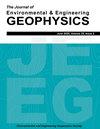A Site-specific Comparison of Permeability Prediction Models in Alluvial Sediments from Physical and Geoelectrical Measurements
IF 0.7
4区 工程技术
Q4 ENGINEERING, GEOLOGICAL
引用次数: 3
Abstract
An evaluation of five petrophysical models for hydraulic permeability predication was completed for a site-specific set of alluvial sediments. The models considered were the Kozeny-Carmen (1927–1937), Börner (1996), Revil-Cathles (1999), and two Revil-Florsch (2010) models. The river deposited sediments represent a relatively narrow grain-size distribution, and were acquired adjacent to the Kansas River, in Olathe, Kansas. Using measured physical, electrical, and hydraulic data from Slater and Glaser (2003) , a comparison of the performance of these five petrophysical models for hydraulic permeability estimation of soils was completed. For models where the key parameter is effective grain-size, three model variations were considered using d10, d50, and d90, resulting in an evaluation of a total of eleven individual models. Parameters included in the models can be classified as three different types: a) physical parameters only, b) electrical parameters only, and c) physical and electrical parameters together. The performance of each model was rated in terms of linear regression R squared, slope, and y-intercept values when plotted against the measured hydraulic conductivities. The top three models were the Kozeny-Carmen, a modified Revil-Cathles, and the Börner model. The Kozeny-Carmen model performed with the highest rating, followed by the modified Revil-Cathles model, and the Börner model rounding out the top three. There was a significant disparity between the rating associated with the top three and the fourth best performing model suggested by Revil and Florsch. However, it should be noted that the Börner model and Revil-Florsch model are based entirely on electrical measurements. The Revil-Cathles model was greatly improved when d10 was substituted for d50 for this limited sediment grain-size range.基于物理和地电测量的冲积沉积物渗透率预测模型在特定地点的比较
对特定地点的冲积沉积层进行了五种岩石物理模型的水力渗透率预测。所考虑的模型是Kozeny-Carmen (1927-1937), Börner (1996), Revil-Cathles(1999)和两个Revil-Florsch(2010)模型。河流沉积的沉积物代表了一个相对狭窄的粒度分布,并且是在堪萨斯州奥拉西的堪萨斯河附近获得的。使用Slater和Glaser(2003)测量的物理、电气和水力数据,完成了这五种岩石物理模型在土壤水力渗透率估算中的性能比较。对于关键参数为有效粒度的模型,使用d10、d50和d90考虑了三种模型变化,从而对总共11个单独的模型进行了评估。模型中包含的参数可分为三种不同的类型:a)仅物理参数,b)仅电气参数,c)物理和电气参数。每个模型的性能都是根据线性回归R平方,斜率和y截距值对测量的水力导率进行评分。排名前三的车型分别是Kozeny-Carmen、Revil-Cathles的改进型和Börner车型。Kozeny-Carmen模型的评分最高,其次是改进后的Revil-Cathles模型,排名前三的是Börner模型。Revil和Florsch给出的前三名和第四名的评分存在显著差异。然而,应该指出的是Börner模型和Revil-Florsch模型完全基于电测量。当用d10代替d50来适应这一有限的泥沙粒度范围时,Revil-Cathles模型得到了极大的改进。
本文章由计算机程序翻译,如有差异,请以英文原文为准。
求助全文
约1分钟内获得全文
求助全文
来源期刊

Journal of Environmental and Engineering Geophysics
地学-地球化学与地球物理
CiteScore
2.70
自引率
0.00%
发文量
13
审稿时长
6 months
期刊介绍:
The JEEG (ISSN 1083-1363) is the peer-reviewed journal of the Environmental and Engineering Geophysical Society (EEGS). JEEG welcomes manuscripts on new developments in near-surface geophysics applied to environmental, engineering, and mining issues, as well as novel near-surface geophysics case histories and descriptions of new hardware aimed at the near-surface geophysics community.
 求助内容:
求助内容: 应助结果提醒方式:
应助结果提醒方式:


